Direct-to-consumer or DTC brands give you complete control over how products reach buyers. You remove the middlemen, own every interaction, and capture real-time insights from every click and purchase. DTC business model allows you to understand user behavior in ways that traditional retail can’t.
In 2025, DTC model continues to dominante the global commerce as more brands shift to digital-first, data-backed operations. So, in this article, you’ll see what drives this growth, how customer patterns are shifting, and which numbers truly matter for your next planning cycle.
P.S. Want to scale your DTC brand without wasting ad spend? inBeat Agency connects you with top-performing micro-influencers who create scroll-stopping UGC that converts. Build authentic visibility, lower your CPAs, and keep your content pipeline full, all with one expert DTC marketing partner. Book a free strategy call now!
Let's start with this short video that explains what DTC is. But, you can skip it and go over to the stats and trend if you already know that:
DTC Industry Statistics, Growth, Market Insights, and More
The DTC industry is constantly evolving as data, pricing, and buyer habits change on a monthly basis. So, you need to track what’s driving that change to plan your next move. To help you out, we've compiled the most important statistics you need to know.
DTC Market Size & Growth
Growth across D2C brands continues to rise as more companies shift to direct-to-consumer (D2C) distribution. These are the latest figures showing how this change is taking shape across different parts of the market.
1. According to Global Insight Services, the global D2C market is projected to expand from about $225.5 billion in 2024 to $880.1 billion by 2034.
This pace shows how direct models are taking larger slices of total retail spending. You’re watching a clear pattern. Brands that invest in customer data and own their channels are outperforming those still tied to wholesale distribution.
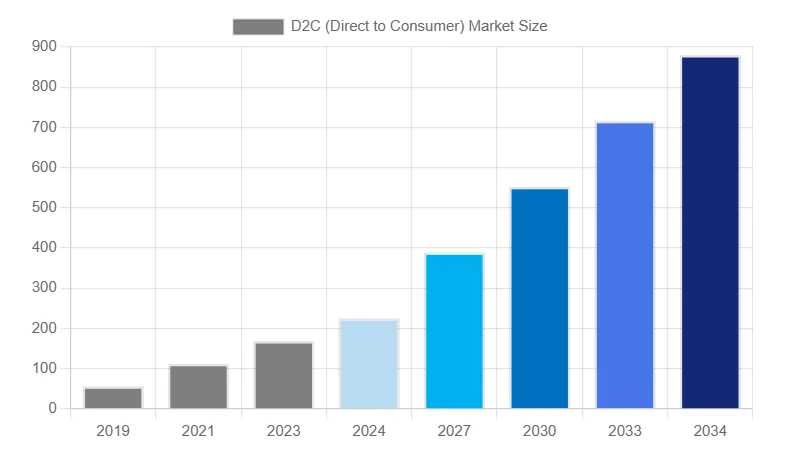
2. Market Research Future forecasts that DTC e-commerce will grow from $80 billion in 2024 to around $270.2 billion by 2035.
That growth points to how e-commerce platforms continue rewarding fast-testing brands. You can act on shopper behavior in real time. This lets you adjust offers or pricing based on performance data without waiting on third-party intermediaries.
3. According to another report from Market Research Future, the global DTC logistics market will expand from about $25.37 billion in 2024 to $75.0 billion by 2035.
Logistics is becoming part of brand identity. Faster fulfillment, accurate tracking, and simple returns build brand loyalty. They turn operational reliability into a marketing advantage that keeps customers coming back.
4. Mordor Intelligence projects the DTC testing market to increase from $4.52 billion in 2025 to $6.33 billion by 2030.
This shows how consumers now expect health and wellness services to be digital-first. Brands providing fast, clear results online reduce friction in the customer journey while also raising trust in accuracy and transparency.
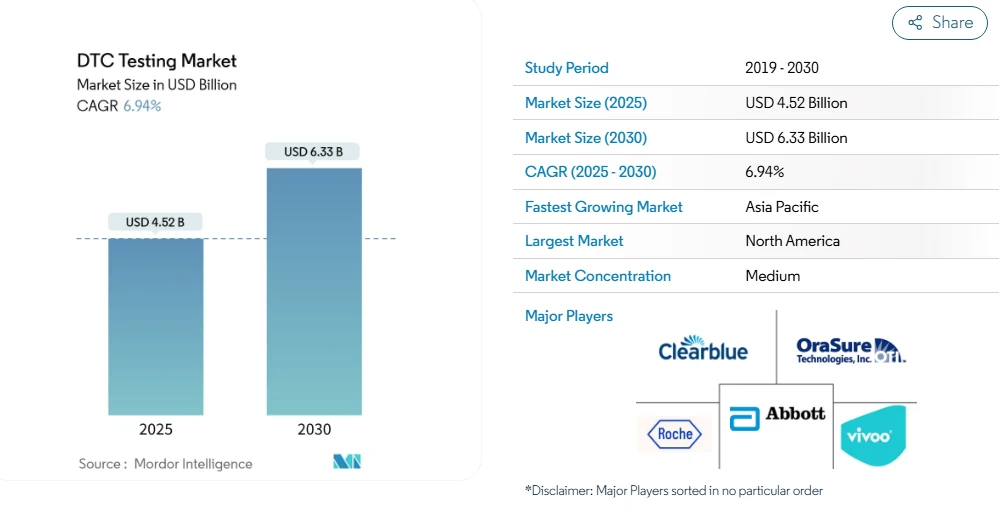
5. Precedence Research reports that the global DTC laboratory testing market will grow from about $3.44 billion in 2024 to $8.07 billion by 2034.
The rise of digital lab testing reflects expanding comfort with self-managed health tools. You see higher adoption where brands communicate data privacy and result reliability clearly. These two factors are directly tied to long-term retention.
6. Global Market Insight projects the DTC genetic testing market to rise from $4.5 billion in 2025 to $13 billion by 2034.
Growth here signals stronger consumer trust in how companies handle sensitive data. You gain a strategic edge when your data practices show accountability and compliance. Privacy and transparency directly drive conversion in this space.
7. According to Maximize Market Research, the direct-to-consumer technology market was valued at $174.68 billion in 2023 and is projected to reach $502.69 billion by 2030.
This jump reflects how digital commerce runs on infrastructure. It means analytics, automation, and content systems that translate user behavior into measurable gains. Building these systems early helps you personalize experiences and compound growth over time.

DTC Consumer Adoption & Demographics Statistics
Adoption continues to grow as more buyers opt for direct channels over retail intermediaries. Here are some of the latest statistics showing who these consumers are and what’s shaping their decisions.
8. Statista reports that social commerce now makes up about 19.4% of all e-commerce.
This shows how social media platforms have become real conversion engines. With these platforms, you’re completing transactions and shaping full customer journeys without relying on external retail partners.
9. Deposco finds that 67% of supply chain leaders have increased investments in DTC fulfillment since 2020.
Operational leaders are clearly aligning logistics with customer-facing goals. When your back-end systems are faster and more integrated, customer experience improves. This leads to stronger repeat-purchase behavior and higher customer lifetime value.
10. Consumer Market Monitor notes that no-contact shopping during 2020 accelerated e-commerce growth by 3-4 years, with digital sales expected to make up about one-third of retail by 2028.
This acceleration didn’t fade after the pandemic. In fact, it set a new baseline. Your ability to build scalable direct systems now depends on how well you apply data analytics to forecast demand and personalize interactions at scale.
11. The same report shows that many larger B2B firms are launching DTC channels to reach wider, more purchase-active audiences.
As enterprise brands enter this space, you face tougher competition for attention and loyalty. Precision in messaging, delivery speed, and content personalization will decide who captures the most profitable segments.
12. The Consumer Market Monitor report finds that over 50% of shoppers now buy from international brands through DTC channels.
Cross-border buying is redefining customer relationships. Brands are no longer competing locally. Pricing, logistics, and cultural context now shape conversion rates for customers who expect consistent service across regions.
Pro tip: If you’re scaling across borders, remember that consistent brand messaging is just as important as pricing or logistics. Check out our list of top 31 brand marketing agencies to find partners who can help you stay on-message while adapting to local markets.
13. According to the same report, AI-driven personalization, AR/VR shopping, drone delivery, and wearable data are near-term adoption drivers.
These technologies change how people interact with digital storefronts. Today, you can see early adopters using generative AI to design faster, hyper-targeted campaigns that connect intent data with creative decisions.
14. Drip research finds that DTC brands now represent around 13% of all e-commerce businesses in the U.S.
That share continues to climb each year. And we can see why: brands owning their data, messaging, and customer loyalty programs grow faster than those dependent on marketplaces for visibility and reach.
15. Invesp reports that Millennials (ages 25-40) and Gen Z (ages 18-24) make up over 60% of DTC purchases.
Here, we're dealing with digital-native buyers who expect instant responses and frictionless payments. This means optimizing every digital touchpoint is non-negotiable. It includes checkout, returns, and communication speed.
16. The same research shows that female consumers account for about 61% of DTC buyers.
Purchase intent here usually connects with value perception and transparency. You gain more trust when messaging, pricing, and policies are clear and supported by visible social commerce activity.
17. According to the same Consumer Market Monitor report that we shared above, 84% of 18-29-year-olds have purchased via social media, compared to 50% of 55-64-year-olds and 47% of 65+.
This generational divide proves why your media targeting strategy must stay flexible. Older buyers still need education and reassurance. Meanwhile, younger audiences respond best to creator-led content and faster feedback loops.
DTC Purchase Statistics: Drivers & Experience
Buying habits are changing fast as shoppers expect more control, speed, and value. These are the latest figures showing what drives purchases and how those experiences shape performance outcomes.
18. According to the same Consumer Market Monitor report, the top drivers behind DTC purchases are better pricing, free delivery, fast service, and more.
Price remains a clear motivator, but convenience and transparency are equally important. The data shows that users now weigh time saved and service ease alongside discounts. Check the image below for the detailed breakdown of each driver:
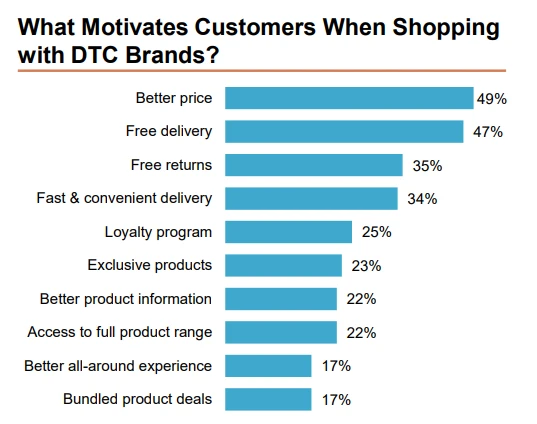
19. Consumer Market Monitor also notes that 34% of online shoppers make weekly purchases due to one-click checkout and targeted ads.
Frictionless checkout flows directly lift conversion. Connecting ad data to purchase behavior allows you to shorten decision cycles and increase repeat buying without expanding traffic volume.
20. The same report shows that mobile accounts for roughly 60% of all e-commerce purchases.
Apart from the report, we also believe that mobile-first design is now the baseline. Optimizing layout, load time, and visibility for smaller screens helps you meet expectations and lower bounce rates across key touchpoints.
Pro tip: Mobile performance now defines how users perceive your brand experience. So, feel free to read our guide about mobile-first advertising to learn creative ways to design campaigns that convert on smaller screens.
21. Consumer Market Monitor reports that 90% of buyers discover new products on social media, and 50% research reviews there before purchasing.
Social proof has become a real performance metric. So, integrating influencer marketing and verified reviews into your funnel lets users validate quality without leaving the platform. This can help you improve purchase intent.
22. McKinsey finds that 71% of consumers expect personalization as a standard.
This expectation reshapes product discovery and retention. If you use machine learning and behavioral triggers, you can create more personalized experiences. This can directly influence your repeat purchase probability and engagement time.
23. According to the same Drip research we shared above, 18% of buyers believe DTC companies offer better service and experience.
This confirms that brand control directly affects perceived value. When you manage support, logistics, and communications internally, you build trust faster and improve every touchpoint in the customer engagement cycle.
Strong customer experience has always been the real differentiator in DTC. It’s what turns first-time buyers into advocates and keeps your brand relevant as competition grows.
“Your brand is not what you sell; it’s the experience you deliver.” - Tony Hsieh, former CEO of Zappos
24. Market Mind Partners notes that over 70% of U.S. shoppers bought from a DTC brand at least once in 2024.
Penetration at this scale means DTC is no longer niche. Competing now depends on loyalty, consistent communication, and better post-purchase care rather than pure acquisition.
25. According to the AI in Retail Global Report, 60% of consumers find most marketing emails irrelevant.
Poor targeting reflects weak segmentation and outdated first-party data use. Refocusing content on context and behavior gives you a measurable lift in engagement and reactivation performance.
26. The AI in Retail Global Report that we have shared above adds that 69% of users are satisfied with AI-driven recommendations.
This proves predictive systems are meeting intent better than traditional recommendation models. You can treat this as a benchmark for refining your own digital innovation roadmap.
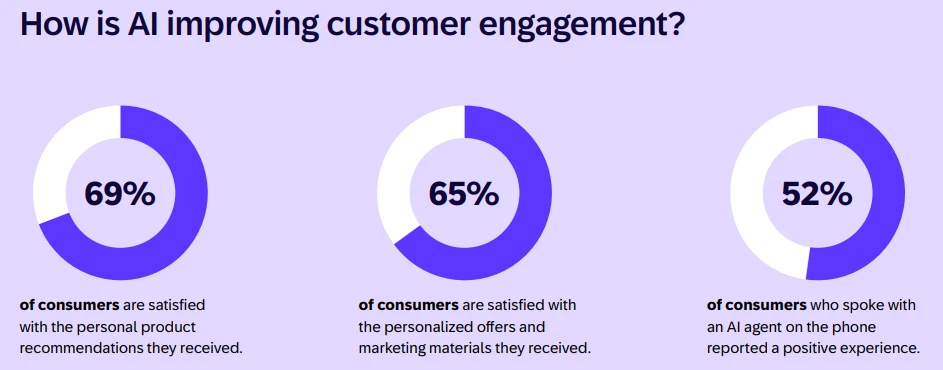
27. According to The Global Consumer Products Engagement Report, 79% of consumers are discouraged when brands ask for a lot of personal data. 73% are put off when brands ask for data but don’t explain how it will be used.
Remember that transparency always drives trust. Clear communication about how data improves service helps prevent churn and ensures compliance with privacy regulations that tighten each year.
28. Over 50% of customers will switch after a single poor experience.
One failed delivery or unclear policy can break long-term value. Continuous testing of checkout flows, response times, and service scripts is critical to protect CLV and reduce preventable losses.
29. BetterCommerce reports that 73% Millennials and 69% of Gen Z shoppers believe DTC brands deliver a more personalized experience.
Younger, digital native buyers expect your messaging to reflect their preferences instantly. The best-performing brands automate relevance at scale while maintaining a human tone and speed of communication.
DTC Sales Statistics: Performance & Loyalty
Sales performance in DTC depends less on traffic and more on repeat conversion. These figures show how direct sales channels and loyalty programs are reshaping growth forecasts and retention strategies.
30. Statista reports that DTC e-commerce sales from established brands have reached $187 billion in 2025, up from $135 billion in 2023.
The jump shows that direct models are reaching maturity. You can see this in the shift from acquisition-heavy campaigns to retention efforts. Reorders and subscriptions now drive a larger share of revenue.
31. eMarketer notes that U.S. DTC e-commerce has reached about $239.75 billion in 2025, accounting for 19.2% of total retail e-commerce.
This projection confirms how fast consumers are consolidating purchases into direct channels. The takeaway is simple: owning your checkout experience and first-party insights is now a growth requirement.

32. Deposco finds that 58% of North American supply chain leaders expect most of their sales to be DTC by 2026.
Operational alignment around DTC means logistics is no longer secondary to marketing. The tighter your fulfillment and omnichannel marketing strategy, the easier it becomes to maintain consistency and reliability for every customer segment.
33. The same Deposco survey also shows that 25% of respondents already generate over 50% of their sales from DTC channels.
That level of integration changes how teams budget and plan promotions. It also pressures traditional distribution models. This forces companies to reallocate spend from retail partners to digital technology and direct communication platforms.
34. According to the Consumer Market Monitor report, U.S. e-commerce sales have increased by 2.3X between 2014 and 2024 and continue to expand.
The steady growth confirms a structural change (not a short-term boom). It proves that hybrid retail is now the most resilient approach to handle demand and pricing fluctuations. This includes balancing DTC and physical stores.
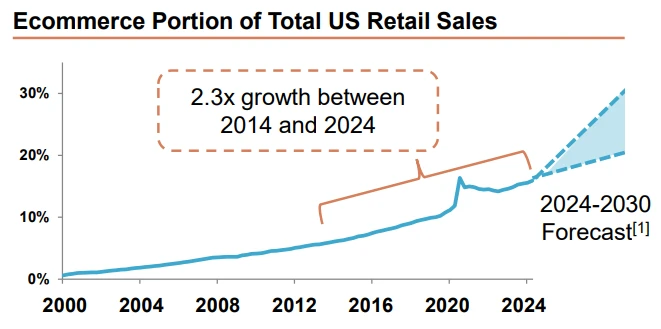
35. NielsenIQ notes that 1 out of every 7 e-commerce dollars worldwide now flows through DTC brands.
That share demonstrates how quickly digital-first ecosystems are scaling. You can track performance by monitoring purchase frequency, repeat order rate, and cart size. Together, they can reveal true customer lifetime value.
36. The 2025 State of DTC Marketing report shows that brands expect social commerce to drive 53% of conversions, influencer marketing 47%, and streaming TV 35% this year.
Performance channels are blending faster than ever. To stay ahead, your attribution models must connect media programs and creative data across platforms to spot where influence actually converts to sales.
37. The same report shows that influencer marketing and retail media will overtake social commerce as high-intent conversion channels.
This shift signals ad fatigue with oversaturated feeds. Diversifying into creator partnerships and performance-based sponsorships gives you better reach and higher-quality conversions without driving ad costs up.
38. Research from EY shows that loyal customers have a 60-70% purchase conversion rate compared to 5-20% for new prospects.
That gap proves loyalty is measurable ROI. Building loyalty programs with tiered incentives or subscription perks protects recurring revenue even when acquisition costs rise.
39. Capital One Shopping research finds that 81% of free-loyalty members shop more frequently, and 76% report higher overall spending.
Such behavior links retention to emotional engagement. Giving customers reasons to return creates momentum that compounds each quarter. This includes exclusive drops, subscription-based models, or early access events.
DTC Advertising Statistics: Marketing Channels & Strategies
Marketing performance depends on how well you connect creative execution with measurable behavior. These figures show how channels, budgets, and content strategies are evolving across advertising & sponsorship programs.
40. Consumer Market Monitor reports that younger consumers are 4 times more likely than those over 65 to be influenced by social media content.
Younger audiences treat platforms like TikTok Shop and Instagram as product discovery tools. Their buying decisions usually start with creator content. This means your ad creative and creator partnerships need to work as seamlessly as your landing page.
41. The same report shows that over 80% of shoppers view a product more positively after friends or family interact with it online.
Peer validation now acts as a conversion multiplier. Campaigns that integrate emotional storytelling and community feedback loops generate higher trust and longer retention across age groups.
42. According to the same report, the top hesitations around social commerce: data privacy and security, lack of customer service return, authenticity, product quality, and scams and fraud.
Each friction point connects directly to brand control. The more transparent your service policies and response systems are, the faster users convert and the easier it becomes to protect long-term reputation.
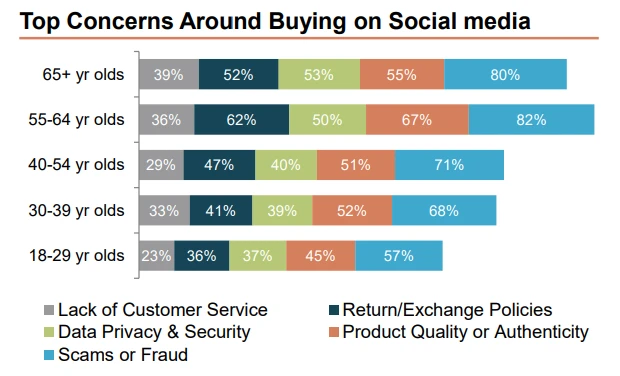
43. The same research calls social media the new search engine for product discovery.
This shift means users skip traditional search entirely. Your focus should move to intent capture. This includes optimizing keywords, captions, and video content that turn impressions into tracked conversions.
44. Consumer Market Monitor also finds that 50% of U.S. shoppers start searches on Amazon, followed by 31.5% on search engines and 14% on brand sites.
Visibility now depends on how you blend direct and marketplace strategies. A healthy omnichannel marketing strategy balances the reach of major platforms with the control of your own store.
Pro tip: Balancing marketplace reach with owned visibility takes careful planning across channels. To help you out, we have created a guide about social media advertising strategies that shows how top e-commerce brands drive discovery and retention together.
45. According to the Motions 2025 Creative Trends report, 85.7% of DTC advertisers are using AI for creative research and 78.6% for production this year.
Automation is reshaping creative cycles. Teams using predictive analytics to identify winning visuals and copy variations before launch cut testing time and media waste dramatically.

46. Yotpo finds that brands using user-generated content in Facebook ads get 4X higher click-through rates and 50% lower cost-per-click.
Real customer proof now outperforms polished creative. When you feature authentic buyer feedback in paid ads, it makes users trust your message faster than any scripted production.
47. The 2025 State of DTC Marketing report that we previously cited shows a sharp shift from third-party to first-party data, with 92% of brands calling it essential.
That change reflects the post-cookie reality. Investing in owned data pipelines and purchase intelligence systems helps you keep targeting precise, even as privacy laws tighten.

48. The same report shows that KPIs are shifting from visibility to profitability, led by conversion rate (75%), customer acquisition cost (63%), customer lifetime value (54%), and average order value (50%).
This change reflects a stronger focus on measurable returns over broad reach. You’re now expected to connect every campaign metric to revenue impact. Impressions or clicks are not the only things worth monitoring.
49. Sender reports that global ad spending has reached $1.17 trillion in 2025, with $798.7 billion going to digital formats.
Budgets follow performance. Digital-first allocation gives you more agility in testing, attribution, and retargeting compared to static offline placements.
50. IAB and PwC report that digital video revenue rose 19.2% year over year to $62.1 billion, now making up 24% of total ad spend.
Short-form video commerce continues to drive engagement across mobile feeds. Performance marketers now treat video as both discovery and conversion. It's important to track click-through rates alongside watch completion.
51. According to the same report, search advertising remains the largest ad segment at $102.9 billion, holding nearly 40% of market share.
Search keeps its lead because intent remains highest there. When you structure campaigns to capture both branded and non-branded searches, you maintain efficiency even as CPMs rise.
52. The IAB and PwC report notes that display advertising grew 12.4% year over year, reaching $74.3 billion.
Rebound in display shows renewed confidence in programmatic targeting. The difference now lies in smarter placement and contextual delivery based on real behavioral triggers.
53. Also, the report showed that podcast advertising revenue grew 26.4% year over year.
Audio content continues to build high trust per impression. For DTC brands, integrating host-read messages into niche podcasts creates strong recall and complements short-form video campaigns.
Pro tip: If you’re planning to test podcast ads or build your own audio presence, you’ll need the right production support. To make it easier, check out our guide on top 30 podcast production agencies to find teams that can help you create high-quality, conversion-driven audio content.
54. From the same report, programmatic ad revenue hit $134.8 billion in 2024, up 18% from 2023.
That increase proves automated buying is still the backbone of digital performance. Fine-tuning data models around audience overlap and creative variation is what separates profitable scale from wasted spend.
55. G2 notes that marketers dedicate 64% of digital ad budgets to mobile, which could reach 70% by 2028.
Mobile remains the conversion center of most campaigns. Every format (from video content to checkout flows) needs to be optimized for fast load times, smaller screens, and native engagement patterns.
DTC Subscription Economy & Platforms
Subscription models have become a key part of DTC growth, but performance now depends more on retention and value than sign-ups. These figures show where the model is gaining traction and where it’s losing ground.
56. The Consumer Market Monitor cites Harvard Business Review and Gartner showing that only 20% of subscription-based businesses improve customer retention.
That low success rate shows how fragile recurring revenue really is. Most churn happens because customers stop seeing clear value. If renewal friction or poor onboarding sets in, you lose recurring revenue that’s harder to replace than first-time sales.
57. According to the Global Consumer Products Engagement Report, 36% of consumers now buy through repeat or subscription models.
Routine and predictability drive this behavior. When you simplify management (pause, swap, or cancel options), you build trust and reduce drop-offs tied to commitment anxiety.
58. Grand View Research values the global subscription economy at $492.34 billion in 2024 and projects it to reach $1,512.14 billion by 2033.
The scale indicates that recurring models are no longer limited to streaming or software services. They’ve expanded into everything from coffee to skincare, where convenience and personalization carry more weight than one-time promotions.
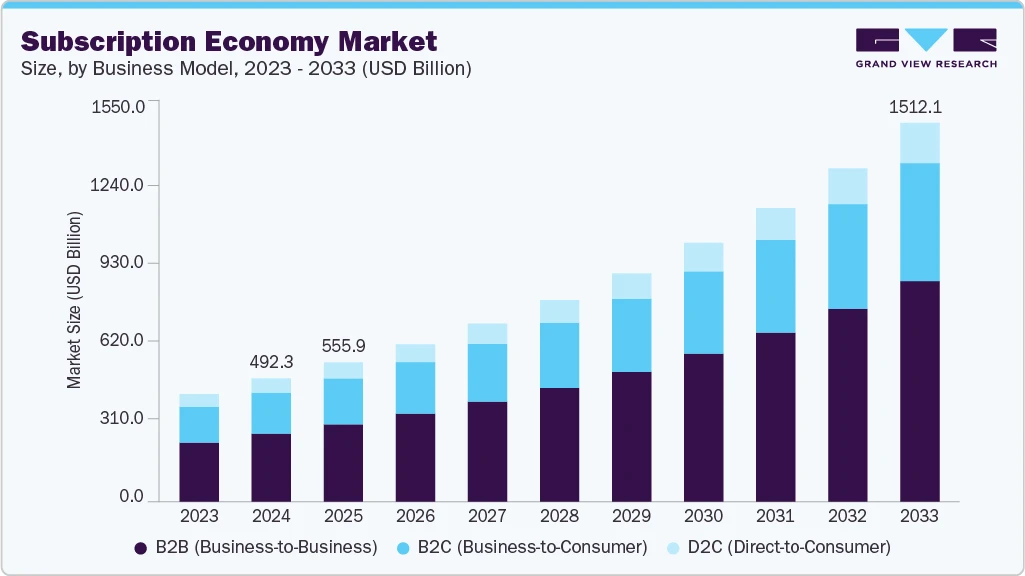
59. The 2024 State of Subscription Commerce report notes that 86% of consumers identify as active subscribers, down slightly from 96% the previous year.
This minor dip suggests the market is stabilizing. You’re now operating in a retention-focused phase, where perceived over-saturation means each renewal requires stronger engagement or clearer added value.
60. World Finance commentary reports that video-on-demand churn rates reached 44% in late 2024.
This volatility shows how fatigue affects even large-scale providers. Regular content updates, tiered rewards, or bundled perks help you balance cost pressure with customer expectations.
61. TrendTrack reports that 81% of consumers want hyper-personalized subscription experiences powered by AI and analytics.
Data-driven relevance matters more than price in renewal decisions. When you use customer behavior patterns to predict timing and recommend next actions, you gain a competitive edge in maintaining engagement.
62. Bango research shows that 88% of subscription brands are seeing higher acquisition costs in 2025.
As paid channels lose efficiency, partnerships become critical. Indirect onboarding through retailers, telecoms, or loyalty networks reduces upfront CAC while building credibility through association.
63. The same Bango study shows that 77% of brands are now expanding indirect acquisition through telcos, banks, and retailers.
Bundled access creates frictionless entry points for users who might not subscribe directly. These integrations extend reach, reduce churn, and turn external ecosystems into steady referral pipelines.
DTC Trends: Emerging Categories & Brand Innovations
Innovation across DTC is now defined by adaptability. These findings show how brands are expanding into new categories, technologies, and models to stay relevant in a crowded market.
64. Deloitte reports that more brands are launching in-house resale or “like new” sections to capture secondhand value.
Resale programs are becoming a profit center instead of a side project. When you manage pre-owned sales internally, you retain brand control. This also helps you reach sustainability-focused buyers and protect pricing integrity on secondary markets.
65. The same Deloitte research shows that more DTC brands are blending online sales with retail partnerships and pop-ups.
Hybrid retail strategies help you meet customers where they shop most frequently. Balancing digital convenience with physical interaction builds stronger trust. It also drives higher conversion rates in high-consideration categories such as fashion and wellness.
66. Chargeflow notes that DTC brands in 2025 are using AI for retention and personalization across every funnel stage.
Predictive churn tools and cross-sell models are now part of baseline operations. These systems help you anticipate drop-offs before they happen and use data-driven prompts to recover potential lost revenue.
67. StartUs Insights finds that more DTC companies are building sustainability and ethics directly into their brand DNA.
Sustainability messaging has evolved from symbolic to structural. Buyers expect transparency on sourcing, packaging, and product lifecycle. Compliance here usually determines long-term loyalty.
68. The same StartUs Insights data notes rising adoption of AR/VR shopping, chatbots, blockchain traceability, and reverse logistics systems.
These tools are helping brands close gaps in engagement and authenticity. And as a result, you see better retention when users can interact virtually and verify sourcing. They also stay longer when they can track post-purchase support without having to switch channels.
69. DeckCommerce shows that flexible payments such as BNPL and split pay remain central to conversion.
Payment freedom reduces checkout hesitation. Brands that let customers control payment schedules see fewer abandoned carts. They also achieve higher average order values, especially in higher-ticket verticals.
70. Analyzify observes that community-led marketing and storytelling are now major DTC differentiators.
Direct selling no longer relies solely on ads. Consistent engagement through user-generated content, micro-communities, and loyalty-driven narratives builds more substantial emotional equity and recurring traffic.
71. SAP Emarsys reports that video commerce and “phygital” experiences (blending digital and physical retail) are gaining traction.
These formats allow real-time interaction and discovery. Live video sessions, in-store digital mirrors, and hybrid events combine engagement with instant purchase options. This turns content directly into measurable sales.
DTC Industry Outlook & Challenges
The DTC sector keeps expanding, but growth now comes with tighter margins, higher costs, and new data hurdles. These insights show where brands are focusing their resources and where the biggest risks are forming.
72. According to the 2025 Consumer Products Industry Outlook, 69% of DTC companies are raising marketing spend. And 76% of companies plan to increase discounts and promotions in 2025.
This signals a push for short-term acquisition to offset slower traffic growth. However, the cost of competing for attention keeps rising. Also, unless retention improves, these tactics can reduce overall profitability.
73. The same report shows that growing discount pressure is leading to thinner margins across DTC.
Deeper promotions might attract new buyers, but they weaken long-term pricing power. You need to balance incentives with perceived value or risk training customers to wait for markdowns instead of paying full price.
74. DTC Times notes how channel diversification makes attribution harder across retail media, streaming, and social.
Fragmented tracking limits visibility into what actually converts. To stay accurate, your analytics systems must consolidate spend data across campaigns. They also need to standardize measurement frameworks to identify where true ROI comes from.
75. According to the same DTC Times report, nearshoring trends and higher input costs are driving operational risk.
Faster delivery expectations now collide with limited capacity and rising expenses. Investing in regional fulfillment or supplier redundancy helps you stabilize performance while protecting delivery reliability.
76. DTC Times also points out that data privacy regulations and cookie restrictions are forcing brands to build direct data pipelines.
This creates an urgent need for better collection and consent systems. The more transparent your process, the easier it becomes to maintain personalization without violating compliance or losing customer trust.
77. Exploding Topics reports that competition within DTC keeps increasing as more brands enter the space.
Market saturation makes it harder to stand out. To sustain growth, you need sharper positioning and differentiated content. You also need measurable proof that your value proposition drives outcomes beyond price or convenience.
Insight: Watch this short video to see how rising costs and weak retention reshaped the DTC boom:
What Can You Learn From These DTC Statistics and Trends?
These insights demonstrate that DTC growth now depends on precision, rather than just expansion. For you, that means turning broad metrics into operational decisions. This includes linking ad spend to profitability, retention to margin recovery, and personalization to renewal rates.
Every number reflects a behavior you can act on. That might mean refining checkout design, adjusting acquisition pacing, or reallocating budget to first-party channels that convert efficiently. The key is to treat your data analytics stack as a decision engine.
When you interpret performance through buyer intent and lifetime value, you move from reactive marketing to predictive execution. These patterns help you spot where loyalty weakens, where spend returns highest, and where your next scalable edge lies.
Ready to Apply These Insights? inBeat Agency Can Help
The DTC playbook is shifting from rapid expansion to smart execution. Growth now depends on how well you turn insights into measurable impact, from refining creative testing to optimizing spend and loyalty strategies. So, the next phase of success lies in creative efficiency.
That’s where inBeat Agency, a leading DTC marketing agency, can help. Our performance-driven creator network gives you scalable content and measurable attribution. We can also help you lower acquisition costs through data-backed influencer and UGC campaigns built to drive consistent, conversion-focused growth.
Are you ready to turn your marketing experiments into predictable growth? Reach out to inBeat Agency to build your next data-powered campaign.
FAQs
Is direct-to-consumer (DTC) growing?
Yes, and you’ve already seen this earlier in the article. Global Insight Services projects the global D2C market to grow from about $225.5 billion in 2024 to $880.1 billion by 2034. This reflects a significant long-term shift toward brands owning their customer relationships and reducing their dependency on platforms.
What is an example of a DTC brand?
Hurom is a good example. It’s a premium juicer company that directly sells its products to its customers. Hurom partnered with inBeat Agency to scale its campaigns while lowering acquisition costs. inBeat helped Hurom cut CPA by roughly 65% and boost ROAS using data-tested UGC and video ads on Meta and Google.
How many D2C brands fail?
Roughly 90% of D2C startups close by their fifth year, based on One Fourth’s analysis. About 30% fail in the first year, and 70% by year three. This typically occurs when scaling too quickly without implementing sustainable retention strategies or establishing clear differentiation.
What is the growth rate of DTC?
Markets & Data estimates a 14.3% CAGR between 2024 and 2031. This shows that DTC remains one of the fastest-expanding retail models globally. Sustained growth will depend on how effectively you use first-party data and customer retention systems to offset rising CAC.
Why are DTC brands failing?
Many fail because they rely too heavily on paid ads while ignoring margins, fulfillment, and loyalty. Inflation and platform saturation have made acquisitions more expensive. inBeat Agency helps you fix this by creating high-performing influencer campaigns that convert efficiently and reduce CAC.
What is the future of DTC brands?
DTC’s future lies in omnichannel integration and more innovative personalization powered by AI and predictive analytics. You’ll see more brands blending physical touchpoints with digital ecosystems and resale models. Those that merge sustainability, data-driven creativity, and brand authenticity will be best positioned to thrive.

